Effect of IL-7 Therapy on Naive and Memory T Cell Homeostasis in Aged Rhesus Macaques
- PMID: 26416281
- PMCID: PMC4617185
- DOI: 10.4049/jimmunol.1500609
Effect of IL-7 Therapy on Naive and Memory T Cell Homeostasis in Aged Rhesus Macaques
Abstract
Aging is associated with gradual deterioration of adaptive immune function, a hallmark of which is the profound loss of naive T cells (TN) associated with decline in thymic output and export of new cells into the peripheral T cell pool. Because the lymphotropic cytokine IL-7 plays crucial roles in both development of TN in the thymus and TN homeostasis in the periphery, we sought to determine the extent to which therapeutic administration of IL-7 could reverse TN deficiency in aging rhesus macaques (RM), either by enhancement of the demonstrably reduced thymopoiesis or by peripheral TN expansion. Our results indicate that treatment of both adult (8-15 y) and old (>20 y) RM with recombinant simian IL-7 (rsIL-7) results in only transient increases in peripheral CD4(+) and CD8(+) TN numbers with no long-term benefit, even with repeated therapy. This transient effect was due to peripheral TN expansion and not enhanced thymic function, and appeared to be limited by induction of IL-7 nonresponsiveness. However, rsIL-7 therapy had a more promising effect on the central memory T cell (TCM) population (both CD4(+) and CD8(+)) in adult and old RM, doubling the numbers of these cells in circulation and maintaining this larger population long term. IL-7 therapy did not reduce TCR diversity of the memory T cell compartment, suggesting that rsIL-7-induced expansion was symmetrical. Thus, although rsIL-7 failed to counter age-associated TN loss, the ability of this therapy to expand clonotypically diverse CD4(+) and CD8(+) TCM populations might potentially improve adaptive immune responsiveness in the elderly.
Copyright © 2015 by The American Association of Immunologists, Inc.
Conflict of interest statement
Figures

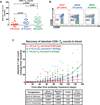
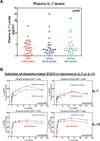
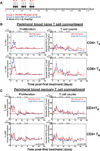

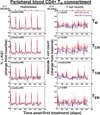
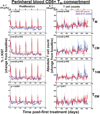


Similar articles
-
Quantification of thymic function by measuring T cell receptor excision circles within peripheral blood and lymphoid tissues in monkeys.Eur J Immunol. 2000 Apr;30(4):1145-53. doi: 10.1002/(SICI)1521-4141(200004)30:4<1145::AID-IMMU1145>3.0.CO;2-7. Eur J Immunol. 2000. PMID: 10760804
-
IL-7 induces immunological improvement in SIV-infected rhesus macaques under antiviral therapy.J Immunol. 2006 Jan 15;176(2):914-22. doi: 10.4049/jimmunol.176.2.914. J Immunol. 2006. PMID: 16393976
-
TCR triggering modulates the responsiveness and homeostatic proliferation of CD4+ thymic emigrants to IL-7 therapy.Blood. 2013 Jun 6;121(23):4684-93. doi: 10.1182/blood-2012-09-458174. Epub 2013 Apr 23. Blood. 2013. PMID: 23613523
-
IL-7: maintaining T-cell memory and achieving homeostasis.Trends Immunol. 2005 Mar;26(3):172-6. doi: 10.1016/j.it.2005.01.004. Trends Immunol. 2005. PMID: 15745860 Review.
-
Aging and T-cell diversity.Exp Gerontol. 2007 May;42(5):400-6. doi: 10.1016/j.exger.2006.11.016. Epub 2007 Jan 10. Exp Gerontol. 2007. PMID: 17218073 Free PMC article. Review.
Cited by
-
Increased Regulatory T-Cell Activity and Enhanced T-Cell Homeostatic Signaling in Slow Progressing HIV-infected Children.Front Immunol. 2019 Feb 12;10:213. doi: 10.3389/fimmu.2019.00213. eCollection 2019. Front Immunol. 2019. PMID: 30809229 Free PMC article.
-
Effect of Anti-IL-15 Administration on T Cell and NK Cell Homeostasis in Rhesus Macaques.J Immunol. 2016 Aug 15;197(4):1183-98. doi: 10.4049/jimmunol.1600065. Epub 2016 Jul 18. J Immunol. 2016. PMID: 27430715 Free PMC article.
-
Lymph nodes as barriers to T-cell rejuvenation in aging mice and nonhuman primates.Aging Cell. 2019 Feb;18(1):e12865. doi: 10.1111/acel.12865. Epub 2018 Nov 14. Aging Cell. 2019. PMID: 30430748 Free PMC article.
-
Compromised steady-state germinal center activity with age in nonhuman primates.Aging Cell. 2020 Feb;19(2):e13087. doi: 10.1111/acel.13087. Epub 2019 Dec 15. Aging Cell. 2020. PMID: 31840398 Free PMC article.
-
The influence of three-dimensional structure on naïve T cell homeostasis and aging.Front Aging. 2022 Nov 7;3:1045648. doi: 10.3389/fragi.2022.1045648. eCollection 2022. Front Aging. 2022. PMID: 36419548 Free PMC article.
References
-
- Sempowski GD, Hale LP, Sundy JS, Massey JM, Koup RA, Douek DC, Patel DD, Haynes BF. Leukemia inhibitory factor, oncostatin M, IL-6, and stem cell factor mRNA expression in human thymus increases with age and is associated with thymic atrophy. J. Immunol. 2000;164:2180–2187. - PubMed
-
- Chen J. Senescence and functional failure in hematopoietic stem cells. Exp. Hematol. 2004;32:1025–1032. - PubMed
-
- Hince M, Sakkal S, Vlahos K, Dudakov J, Boyd R, Chidgey A. The role of sex steroids and gonadectomy in the control of thymic involution. Cell. Immunol. 2008;252:122–138. - PubMed
Publication types
MeSH terms
Substances
Grants and funding
LinkOut - more resources
Full Text Sources
Other Literature Sources
Medical
Research Materials

